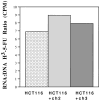Mismatch repair proficiency and in vitro response to 5-fluorouracil
- PMID: 10381918
- PMCID: PMC4343206
- DOI: 10.1016/s0016-5085(99)70558-5
Mismatch repair proficiency and in vitro response to 5-fluorouracil
Abstract
Background & aims: The DNA mismatch repair (MMR) system recognizes certain DNA adducts caused by alkylation damage in addition to its role in recognizing and directing repair of interstrand nucleotide mismatches and slippage mistakes at microsatellite sequences. Because defects in the MMR system can confer tolerance to acquired DNA damage and, by inference, the toxic effects of certain chemotherapeutic agents, we investigated the effect of 5-fluorouracil (5-FU) on colon cancer cell lines.
Methods: We determined growth selection by cell enrichment assay and cloning efficiency after treatment with 5 micromol/L 5-FU, assayed nucleic 3H-5-FU incorporation, and analyzed the cell cycle by flow cytometry.
Results: 5-FU treatment provided a growth advantage for MMR-deficient cell lines, indicating a relative degree of tolerance to 5-FU by the MMR-deficient cell lines. Enhanced survival was statistically significant after 5 days of growth, and a 28-fold reduction in survival was noted in the MMR-proficient cells by clonagenic assays after 10 days of growth. Differences in nucleotide uptake of 5-FU did not account for the observed growth differences, and specific cell cycle checkpoint arrest was not detected.
Conclusions: Intact DNA MMR seems to recognize 5-FU incorporated into DNA but may do so in a different manner than other types of alkylation damage. Defective DNA MMR might be one mechanism for tumor resistance to 5-FU.
Figures



References
-
- Marra G, Boland CR. DNA repair and colorectal cancer. Gastroenterol Clin North Am. 1996;25:755–772. - PubMed
-
- Marra G, Boland CR. Hereditary nonpolyposis colorectal cancer: the syndrome the genes and historical perspectives. J Natl Cancer Inst. 1996;87:1114–1125. - PubMed
-
- Thibodeau SN, Bren G, Schaid D. Microsatellite instability in cancer of the proximal colon. Science. 1993;260:816–819. - PubMed
-
- Markowitz S, Wang J, Myeroff L, Parsons R, Sun LZ, Lutterbaugh J, Fan RS, Zborowska E, Kinzler KW, Vogelstein B, Brattain M, Willson JKV. Inactivation of the type II TGF-β receptor in colon cancer cells with microsatellite instability. Science. 1995;268:1336–1338. - PubMed
-
- Souza RF, Appel R, Yin J, Wang S, Smolinski KN, Abraham JM, Zou TT, Shi YQ, Lei J, Cottrell J, Cymes K, Biden K, Simms L, Leggett B, Lynch PM, Frazier M, Powell SM, Harpaz N, Sugimura H, Young J, Meltzer SJ. Microsatellite instability in the insulin-like growth factor receptor gene in gastrointestinal tumours. Nat Genet. 1996;14:255–257. - PubMed
Publication types
MeSH terms
Substances
Grants and funding
LinkOut - more resources
Full Text Sources

